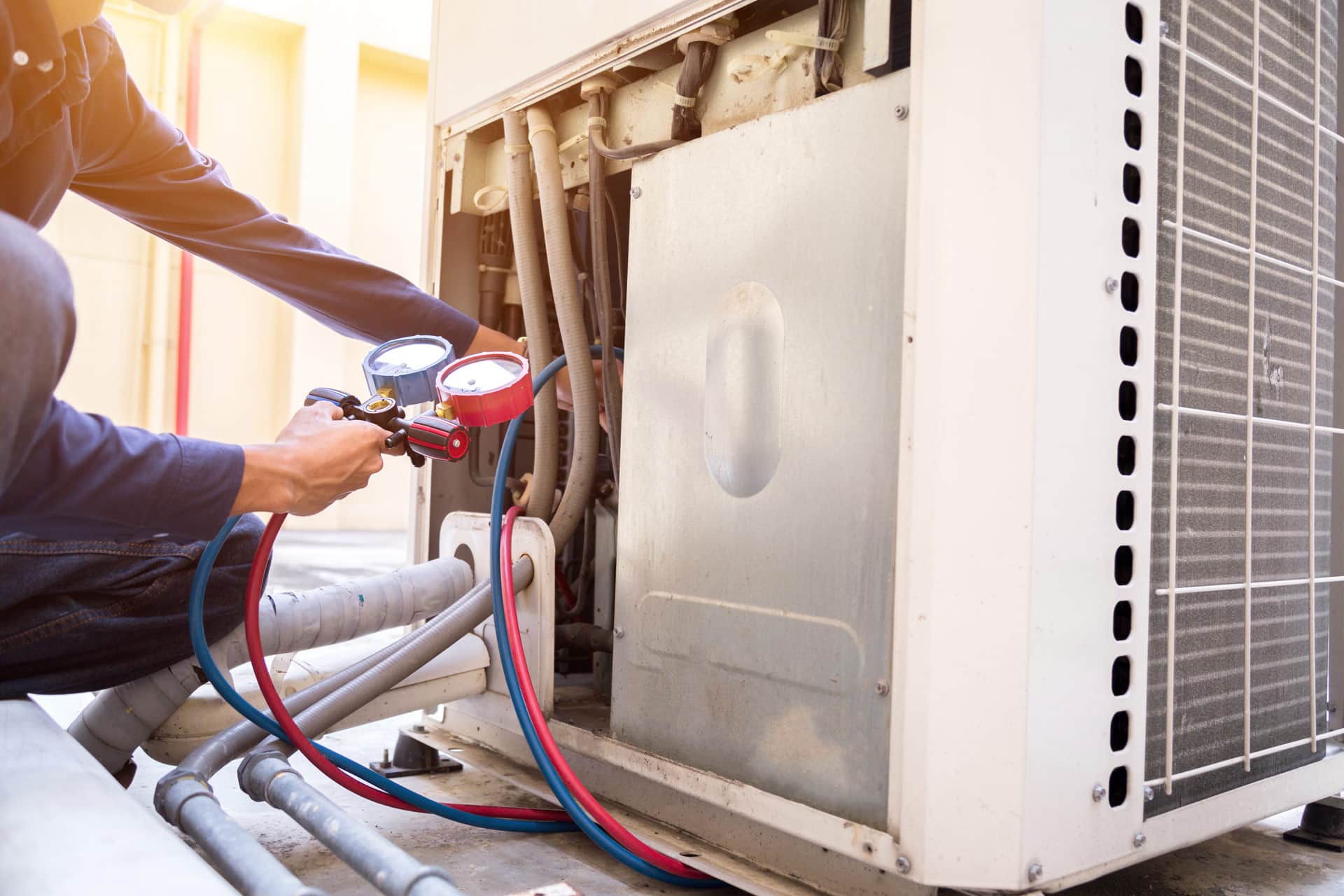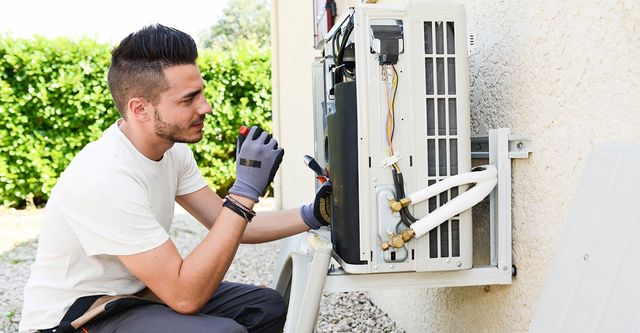The 15-Second Trick For Ac Fixing
The 15-Second Trick For Ac Fixing
Blog Article
Air Conditioner Air Conditioning System Repair Work: Repair Work The Cooling System To Restore Comfy Indoor Temperatures
Identifying Common A/c Unit Problems
Ever found yourself sweltering in the middle of a heatwave, only to understand your ac system isn't cooling as it should? It's frustrating, however more common than you might think. Numerous homeowners deal with these problems annual, from weird noises to uneven air flow. Why does this happen?
Top Concerns That Often Turn Up
- Refrigerant Leaks: When the cooling representative leaks, the a/c struggles to chill the air, leaving you with hot blasts rather of rejuvenating breezes.
- Frozen Evaporator Coils: Ever observed ice buildup? It's an indication the system's working overtime or airflow is obstructed.
- Clogged Air Filters: Dust and debris can choke the system, causing it to labor more difficult and possibly overheat.
- Faulty Thermostat: In some cases, the perpetrator is as easy as a misreading thermostat, sending incorrect signals to your system.
- Drain Issues: Water pooling around the system? Obstructed drainage lines may be the tricky villain here.
How to Recognize These Problems Early
Is your a/c making strange noises-- a grinding or rattling? That's a warning. Or has your electrical costs inexplicably increased more info without a change in usage? Ineffectiveness frequently hides behind such hints.

| Symptom | Possible Cause | Quick Repair Suggestion |
|---|---|---|
| Warm air blowing | Low refrigerant or compressor failure | Inspect refrigerant levels; call a professional for compressor issues |
| Unit will not switch on | Electrical problems or thermostat malfunction | Reset breaker; replace thermostat batteries |
| Water leak | Blocked drain line | Clear drain with a wet/dry vacuum |
Why Do These Issues Take place?
Think of your a/c as a fragile community. Disrupt one part, and the entire system stumbles. In some cases, it's disregard-- a forgotten filter change-- or external factors like power surges. What's clear is that neglecting early signs just turns small glitches into major headaches.
Necessary Tools for Air Conditioner Repair Work
Ever discovered yourself staring at a frozen evaporator coil or a stubborn compressor that declines to hum back to life? You'll quickly realize that having the right tools isn't simply a benefit-- it's a requirement. Think of attempting to gauge refrigerant pressure with a damaged gauge or patching a leakage without a correct vacuum pump. The frustration is genuine, however the option depends on preparation.
Core Tools Every Professional Should Have

- Manifold Gauge Set: For accurate measurement of refrigerant pressures-- this is your diagnostic compass.
- Vacuum Pump: Getting rid of wetness and air from the system is important; avoiding this action threats contamination.
- Multimeter: Electricity flows calmly, however a multimeter speaks volumes about voltage, current, and continuity.
- Fin Comb: Bent fins on the condenser can choke airflow. This basic tool brings back airflow performance quickly.
- Refrigerant Leak Detector: Pinpoint evasive leakages that might otherwise fly under the radar.
Pro Tips for Utilizing Your Tools
- Never ever connect gauges without very first confirming the system is off. It avoids damage to your instruments and safeguards your fingers.
- When using the vacuum pump, run it for a minimum of 30 minutes to ensure all wetness is extracted-- shortcuts here result in system failure.
- Calibrate your multimeter frequently; even slight errors can mislead repairing efforts.
- Utilize the fin comb carefully; extreme force can trigger additional damage.
What's often ignored is how these tools interplay. For instance, a refrigerant leakage detector guides where to connect your manifold gauges to evaluate pressure drops accurately. Have you ever discovered how an easy tool swap can shave hours off a repair job? That's the kind of efficiency every service technician craves.
Step-by-Step Repair Work Instructions for Your Air Conditioning System
Ever stood sweating while gazing at a persistent air conditioner system that refuses to cool? The buzzing hum that unexpectedly becomes silence can be frustrating. How do you even begin to untangle this web of mechanical wrongdoing? Let's cut through the confusion with a clear, expert-guided procedure.
1. Detect the Core Concern
Before diving into repairs, ask: is the issue electrical, mechanical, or refrigerant-related? A fast test-- shut off the system and examine the circuit breaker. Tripped breakers typically conceal the origin. Next, examine the thermostat settings. Sometimes, the repair is as simple as recalibrating your thermostat or replacing its batteries.
2. Examine the Air Filter and Coils
A stopped up filter or filthy coils can choke your a/c unit's effectiveness. Take out the filter:
- If it looks dirty or dusty, swap it right away.
- Utilize a vacuum or soft brush to clean up the evaporator coils gently.
Keep in mind, a disregarded filter resembles attempting to breathe through a scarf in a sauna-- inefficient and frustrating.
3. Analyze the Condensate Drain
Blocked drains lead to water buildup, setting off sensor shutdowns. Utilize a stiff wire or a wet/dry vacuum to clear the drain line. This fast fix avoids leaks that can cause bigger headaches.
4. Test the Capacitor and Fan Motor
These components typically fail calmly. Using a multimeter, examine the capacitor for voltage consistency. If readings change wildly or check out absolutely no, replacement is in order. For the fan motor, listen for grinding or irregular spinning-- indications of imminent failure.
Quick Referral Table: Typical Signs and Fixes
| Sign | Probable Cause | Expert Idea |
|---|---|---|
| Air conditioning not cooling | Unclean filter or low refrigerant | Tidy filter first; look for leaks with soapy water |
| Unit will not begin | Tripped breaker or defective capacitor | Reset breaker; test capacitor with multimeter |
| Water leaking inside | Blocked condensate drain | Clear drain line to avoid overflow |
Now, you might question, "Is it truly worth trying to repair this myself?" Consider this: numerous repairs depend upon patience and the right tools instead of raw technical ability. A constant hand and a little troubleshooting can save hours and dollars. As with any elaborate machine, the key depend on comprehending its language-- the hums, clicks, and silences-- and reacting accordingly.
Unlocking Durability: Preventive Upkeep Tips for Air Conditioner Units
Ever observed how a whispering breeze can turn into a suppressing heater when your a/c fails? That subtle hum is often the first indication of hidden pressure. Neglecting these whispers can cause a complete breakdown just when you need cool relief the a lot of. What if you could catch these early murmurs before they escalate?
Start with the filter. It's easy to ignore, yet a blocked filter chokes airflow, forcing your system to work overtime and spike energy usage. Changing or cleaning up filters every one month during peak use isn't simply good practice; it's a lifesaver for your air conditioner's performance.
Key Preventive Steps:
- Check the coils: Dirt accumulation on evaporator and condenser coils minimizes heat absorption and release. A mild brush or vacuum can restore their pristine condition.
- Clear the condensate drain: Blockages here can cause water damage and boost indoor humidity. A simple wire or compressed air blast can keep this course clear.
- Examine refrigerant levels: Too low, and your air conditioning strains to cool; expensive, and it runs the risk of compressor damage. Just certified technicians need to manage refrigerant modifications.
- Test the thermostat's precision to prevent unneeded biking or pain.
Remember the story of the old system that froze solid one summer? The culprit was a small leak that sneaked past unnoticed. Little concerns typically mimic normal wear however substance rapidly. Staying ahead with regular assessments and seasonal tune-ups can avoid these concealed disturbances.
| Maintenance Job | Frequency | Impact |
|---|---|---|
| Filter Replacement | Every one month | Enhances air flow and decreases strain |
| Coil Cleansing | Every year | Enhances heat exchange efficiency |
| Drain Clearing | Quarterly | Prevents water damage and mold growth |
| Refrigerant Check | Each year | Guarantees ideal cooling efficiency |
Isn't it curious how the tiniest tweaks-- like tightening loose electrical connections or lubing moving parts-- can spin your air conditioner back to peak type? These aren't just fixes; they're investments in convenience. After all, a properly maintained unit does not just cool; it whispers cool serenity, even in the most sweltering heat.
A/c Unit Repair Services in Jacksonville, FL
Jacksonville, FL, is a vibrant city understood for its substantial park system, stunning beaches, and dynamic cultural scene. As the most populous city in Florida, it provides a diverse variety of outdoor activities consisting of fishing, boating, and exploring the Timucuan Ecological and Historic Preserve. The city's warm climate makes cooling an important part of daily convenience for residents and companies alike.
For those needing to fix air conditioning unit, Bold City Heating and Air offers expert assessment and advice. They are prepared to assist guarantee your cooling system runs effectively through Jacksonville's hot seasons. Connect to them for a free assessment to resolve your a/c repair requirements.
Report this page